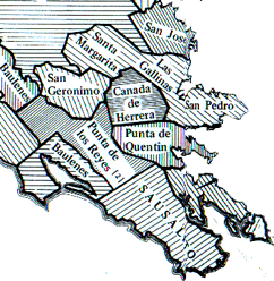|
|
|
|
| |
 Land History Land History |
|
| |
About JBR Coopers’ Land History
MONTEREY COUNTY, CA
1829. |
 |
| |
Cooper purchases Rancho Bolsa de Potero y Moro Cojo. |
In 1829, Mr. Cooper bought 7000 acres of the ranch known as Bolsa del Potrero y Moro Cojo (Pocket of the Pasture and the Lame Moor) and also as La Sagrada Familia (the Holy Family) from Jose Joaquin de la Torre, to who it had originally been granted. It lay between the Salinas River ant the Tembladero Slough, near present Castroville.
1834-1840. Cooper acquires Rancho El Sur
The El Sur grant was made in 1834 by Governor Jose Figueroa to Juan Bautista Alvardo. The grant was for two leagues of land, or roughly 8,880 acres. The expedient filed by Alvarado on May 14, 1834 stated that he had first petitioned for a provisional grant on August 12, 1830, and repeated his petition on February 26, 1831. It further asserted that he maintained "at this time . . . more than three hundred head of large cattle and nearly an (sic) hundred horses, all my own property, and have built a house and pens."
Soon after the grant was made, the property was acquired by Captain J.B.R. Cooper, Alvarado's uncle by marriage. Although no official transfer was made until 1840, Cooper seems to have been directly involved in the management of the ranch as early as 1834, when he entered into an agreement with Job Dye for the latter to raise mules on the property.
1859. Bolsa de Potrero y Moro Cojo - Mexican Land Grant
When the United States took possession of California and other Mexican lands in 1848, it was bound by the Treaty of Guadalupe Hidalgo to honor the legitimate land claims of Mexican citizens residing in those captured territories. In order to investigate and confirm titles in California, American officials acquired the provincial records of the Spanish and Mexican governments in Monterey. Those records, most of which were transferred to the U. S. Surveyor General’s Office in San Francisco, included land deeds, sketch-maps, and various other documents. The Land Act of 1851 established a board of land commissioners to review these records and adjudicate claims, and charged the Surveyor General with surveying confirmed land grants. Of the 813 grants ultimately claimed, the land commission approved only 553.
|
| |
| 1827. The Cooper-Molera Adobe |
 |
First occupied by the Cooper family in 1827 and owned by descendants until 1968, the Cooper-Molera tells the story of Monterey through the life and times of John Rogers Cooper, a New England sea captain, his half brother Thomas O. Larkin, Cooper's wife, Encarnacion Vallejo de Cooper and the Cooper family through three generations
California life in the 1850s is depicted in this 3-acre complex by living history demonstration, farm animals and historic vegetable and flower gardens. The buildings reflect the period from 1823, when Monterey was the major city in California, to 1900, when it had waned to a small town. |
| |
| MARIN |
COUNTY  |
| |
| |
1840. JBR Cooper granted Rancho Punta de San Quentin Marin County, CA
Captain Juan B. R. Cooper, was granted "Rancho Punta de Quentin" (an 8,877 acre property) by Mexican Governor Juan Bautista Alvarado. Cooper was licensed to hunt otter, prevalent at the mouth of the Corte Madera Creek
1844. Rancho Nicasio granted to Pablo de la Guerro & JBR Cooper
By 1843, most of the north bay had been claimed by a handful of Mexican Californians and recent European and American immigrants who became Mexican citizens in order to acquire title. Pablo de la Guerra and John B.R. Cooper,
sensing that time was running out, filed a formal petition for Rancho Nicasio
that same year. They received the title to it in 1844 [34]. Although the
Nicasio Indians were allowed to remain on the land, they were now
dispossessed, a fact which did not seem to discourage either Vallejo or the
Mexican government.
|
|
 |
|
1852. JBR Cooper sells Rancho Punta de San Quentin
"Rancho Punta de Quentin" sold by Juan Cooper to Benjamin Buckelew for $50,000 in gold coin. Buckelew continued the timbering and sold 20 acres to the State of California for a prison site (San Quentin today). The price was $10,000. |
| |
SONOMA COUNTY
California Landmark 835. Cooper's Sawmill |
| |
 |
|
In 1834, Mariano G. Vallejo's brother-in-law, John B. R. Cooper, constructed California's first known power-operated commercial sawmill. In addition to sawing redwood lumber, the mill and surrounding settlement served as a barrier to Russian encroachment from the west. Located on Mark West Creek, the waterpowered mill was destroyed by flood in the winter of 1840-41. |
|
Location: Southwest Corner of the Intersection of Mirabel and River Roads. Eight Miles West of Santa Rosa.
1835-1850. JBR Cooper, Mariano Vallejo & The District of Sonoma
Sonoma, (meaning “Valley of the Moon” in the language of the Chocyyen Indians) comes under the military rule of General Mariano Guadalupe Vallejo. Vallejo, through Juan Bautista Rogers Cooper, a Yankee captain who had become a Mexican citizen, offers land grants (in what would become the greater Occidental area) to three of Cooper’s sailors, James Dawson, James Black and Edward McIntosh, for the purpose of creating a “buffer zone” to halt Russian settlement. While the land is under Mexican rule, a number of other U.S. citizens apply for Mexican citizenship in order to qualify for land grants.
The foreigners to whom land was granted in this section were Jacob P. Leese, John Fitch, Juan Cooper, John Wilson and Mark West. The three former were brothers-in-law of General Vallejo. The site of the present town of Santa Rosa was granted to Mrs. Carrillo, the mother of Julio Carrillo, and the country between Santa Rosa and Sebastopol, to Joaquin Carrillo, a brother of Mrs. Vallejo. Captain Stephen Smith was granted the Bodega ranch, which included thirty-five thousand four hundred and eighty-seven acres. Captain Smith was a remarkable man; he came to California from Chili, and was a fine type of the pioneer, honest, hospitable and generous to a fault. Juan B. Cooper was another old sea-captain; he owned the rancho "El Molino," translated--the mill-ranch. He had just gotten up his mill when a tremendous freshet came in 1840-41, and washed it all away. The Ross ranch was granted to Manuel Torres. The German ranch on the coast above Ross was granted to a number of Germans, and they gave to the stream which flowed through their land the appropriate name of Valhalla. |
|
|
| |
|
|
|
| |
|